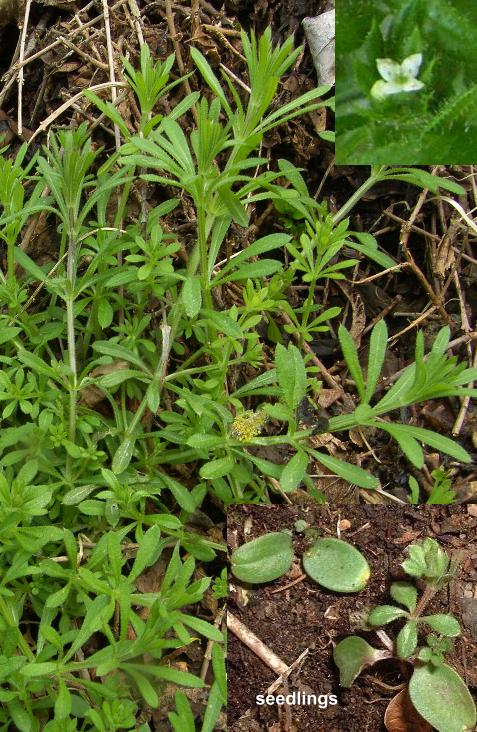CleaversScientific Name : Galium aparine |
Annual, spreading by seed which develop in a fruit covered with small hooked barbs for attaching them to the fur of passing animals for dispersal. The square stems and the leaves also have tiny
barbs so the whole plant can become entangled with a passerby. As children we used it as a sticky missile when playing. It scrambles up through plants
and hedges and a dense clump can overwhelm weaker plants causing collapse.
One of the common names in some countries is Goose Grass, but is not the true Goosegrass (Eleusine indica) which can be a lawn weed-grass.
A spring tonic can be prepared by infusing the fresh topgrowth, and it has been used for some ailments as well, such as cystitis, psoriasis and eczema. It is the young growth that is used. The leaves and stems can be cooked as a spinach if picked before the seeds form. The seeds can be roasted and brewed to make a coffee substitute. A tangle of the stems was used to strain milk to remove hairs and other debris.
The small white, star-like flowers appear from June to August and are self-pollinated. They produce a barbed, spherical seed capsule about 3 to 4 mm in diameter, either singly or in pairs. Most fall close to the parent, but they remain 'sticky' as they dry and can be carried away on anything which approaches too close. Among crops the distribution can be shown to follow the direction of harvesting machinery as the seeds fall from the disturbed stems. Some germinate in the autumn and the rest in the following spring or remain viable in the soil for 2-3 years.
Height - up to 150 cm.
Hoeing the seedlings or hand pulling is the easiest option, but the stringy stem at the base is quite tough allowing the upper growth to break off leaving it behind to regrow, so follow the plant down to ground level to get all of it out. Remove before seed set, preferably
at seedling stage in late autumn or spring, but they can germinate throughout winter as well if the weather is mild.
Weedkillers to use:-
A residual agent to suppress germination of seeds.
Paraquat, Diquat kill top growth on contact, but not much use if
growing through other plants.
Nicholas Culpepper
(17th century astrologer-physician)
"The juice of the herb and seed together, taken in wine, helpeth those bitten by an adder by preserving the heart from the venom.
The distilled water drunk twice a day helpeth the yellow jaundice. The decoction of the herb stayeth laxes and bloody fluxes. The juice of the leaves, or the bruised leaves, applied to a wound stayeth the bleeding. Boiled in hog's grease, it helpeth all sorts of hard swellings or kernels in the throat when anointed."
Flux - excess flow of any body secretion.
Follow these links for further details on Weeds, Weed Removal and Weed Prevention.
